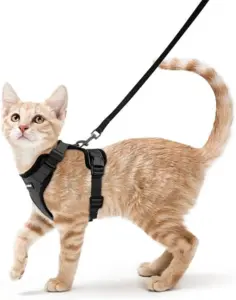
How to Leash Train Your Cat: A Step-by-Step Guide for Cat Parents
Table of Contents
Leash training a cat may sound unconventional to some, but it’s gaining popularity among cat owners who want to safely introduce their feline friends to the great outdoors. Whether you’re a seasoned cat parent or a new fur baby enthusiast, leash training can open up a world of enrichment for your pet. In this guide, we’ll walk you through everything you need to know about leash training your cat—covering the benefits, the tools you’ll need, and practical steps to get started.
Why Leash Train Your Cat?
Leash training is about more than just walking your cat outside; it’s a way to enhance their mental and physical well-being. Cats are naturally curious creatures, and leash training allows them to safely explore their surroundings. Here are some key benefits:
- Mental Stimulation: Outdoor adventures provide new sights, smells, and sounds that keep your cat engaged and curious.
- Physical Exercise: Indoor cats often don’t get enough activity. Leash training encourages healthy movement and play.
- Bonding Opportunity: Training sessions help strengthen your relationship with your cat.
- Safe Exploration: A leash offers freedom without the risks of letting your cat roam freely outdoors.
Tools You’ll Need to Get Started:
Before you dive into training, gather these essential tools:
- Cat Harness: Choose a harness designed specifically for cats. Look for options that are adjustable, comfortable, and secure.
- Leash: A lightweight, non-retractable leash works best for training. Start with one that’s 4–6 feet long.
- Treats: Use your cat’s favorite treats as positive reinforcement.
- Patience: This isn’t a physical tool, but it’s the most important thing you’ll need!
Step-by-Step Guide to Leash Training Your Cat

Step 1: Choose the Right Harness
The harness is your cat’s gateway to leash training. Pick one that fits snugly but isn’t too tight. You should be able to fit two fingers between the harness and your cat’s body. Try it on indoors and let your cat get used to the feeling.
Step 2: Get Your Cat Comfortable Indoors
Once your cat is wearing the harness, attach the leash and let them drag it around the house. This helps them acclimate to the sensation without the pressure of being outdoors.
Step 3: Use Positive Reinforcement
Whenever your cat wears the harness without resistance, reward them with treats and praise. This creates a positive association with the gear.
Step 4: Practice Indoors
Start walking your cat indoors. Gently guide them with the leash, using treats to encourage them to move forward. Be patient—cats often need time to adapt.
Step 5: Take the Training Outside
Choose a quiet, secure outdoor space like a backyard or patio. Keep initial sessions short, around 5–10 minutes, and stay close to home. Let your cat explore at their own pace while keeping a gentle hold on the leash.
Step 6: Gradually Expand Their Comfort Zone
As your cat becomes more confident, you can extend the duration and explore new areas. Always remain vigilant for potential dangers, such as cars or other animals.
Tips for a Successful Training Experience
- Stay Calm: Cats are sensitive to emotions. Keep your demeanor relaxed and positive. If you’re feeling stressed or rushed, your cat will pick up on that energy and may become anxious. Practice deep breathing before and during your training sessions to ensure you remain calm and reassuring.
- Avoid Forcing Them: If your cat resists the harness or leash, take a step back and give them time to adjust. Forcing them can lead to a fear of the training process. Instead, create a safe and comfortable environment by introducing the harness slowly, rewarding small milestones, and letting your cat set the pace.
- Be Consistent: Establish a regular training schedule. Short, daily sessions work better than infrequent, longer ones. Cats thrive on routine, and consistency helps them build confidence and understand what’s expected of them.
- Monitor the Environment: Always be aware of your surroundings during outdoor training sessions. Loud noises, unfamiliar animals, or busy streets can frighten your cat and disrupt the training process. Start in quiet, enclosed areas and gradually introduce new stimuli as your cat grows more comfortable.
Common Challenges and How to Overcome Them
- Resistance to the Harness: If your cat dislikes the harness, start by leaving it near their favorite resting spot. Allow them to sniff and explore it at their own pace. Place treats on or near the harness to create positive associations. When you first put it on, keep the sessions brief and reward them generously for tolerating it.
- Fear of the Outdoors: For cats that are hesitant to step outside, begin by opening a window or door to let them experience outdoor sounds and smells while remaining indoors. Gradually move to a secure patio or garden, allowing them to observe the environment without pressure. Celebrate small steps, like stepping onto a porch or sniffing the grass.
- Distractions: Outdoor environments can be full of overwhelming stimuli, from birds to passing cars. Stay close to your cat, use treats to maintain their focus, and offer verbal encouragement. If a distraction causes fear, calmly guide them back to a familiar spot and allow them to settle before continuing.
DIY: Make Your Own Cat Leash and Harness Setup
If you’re feeling crafty or want a budget-friendly alternative, consider creating a DIY leash and harness setup. Here’s how:
Materials You’ll Need:
- 1–2 yards of durable, non-stretch fabric (like nylon or polyester)
- Adjustable buckles and clips
- A lightweight cord or leash rope
- Sewing machine or strong adhesive
Instructions:
- Create the Harness: Cut the fabric to form two loops—one for the neck and one for the chest. Secure the loops with adjustable buckles to ensure a snug fit without being too tight.
- Attach the Leash Clip: Sew or securely attach a metal clip to the back of the harness.
- Make the Leash: Use the cord or rope to create a leash, attaching a clip at one end to connect to the harness.
- Test It Out: Before using it outdoors, test the setup indoors to ensure it’s comfortable and secure for your cat.
How To Leash Train Your Cat FAQ: Addressing Common Concerns
How do you know if leash training is right for your cat?
If your cat shows curiosity and a willingness to explore, leash training might be a great way to enhance their life. However, if your cat tends to be overly anxious or timid, leash training may require extra patience and care. Observe your cat’s behavior indoors before making a decision.
Can all cats be leash-trained?
While many cats can adapt to leash training with the right approach, not every cat is suited for it. Cats with outgoing, curious personalities are more likely to enjoy the process. On the other hand, cats with a history of trauma or fear may need more time and reassurance to feel comfortable.
How long does it take to leash train a cat?
Every cat is unique, so the time it takes to leash train one varies greatly. Some cats may adapt in just a few days, while others may require several weeks or even months of consistent practice. The key is to be patient and let your cat progress at their own pace.
Is leash training safe?
Absolutely—when done correctly. Safety starts with choosing the right harness and leash, ensuring a secure fit. Always supervise your cat during outdoor excursions, keep an eye on potential hazards like cars or stray animals, and stay vigilant to ensure their well-being throughout the experience.
Featured Product: rabbitgoo Cat Harness and Leash
Looking for the perfect gear to start leash training your cat? The Rabbitgoo Cat Harness and Leash is a top-rated choice among cat parents. Designed for safety, comfort, and ease of use, it’s ideal for outdoor adventures or trips to the vet.
Key Highlights:
- Comfortable Fit: Soft, breathable mesh keeps your cat cool and cozy during walks.
- Escape-Proof Design: Adjustable straps and sturdy buckles ensure a secure fit.
- Reflective Strips: Provides added safety during low-light outings.
- Easy to Use: Quick on-and-off setup with customizable adjustments for the perfect fit.
This lightweight harness is perfect for beginners and seasoned leash trainers alike. Ready to give your cat the adventure they deserve?
Why Leash Training Is Perfect for Urban Cat Owners
For city dwellers, leash training is an excellent way to provide your apartment-dwelling cat with the stimulation they crave. Imagine turning rooftop gardens, cozy courtyards, or even serene sidewalks into an exciting playground for your feline companion. With the right approach, urban cats can enjoy the sights, sounds, and scents of the outdoors while staying safe. This method not only enriches their lives but also adds a touch of adventure to your daily routine.
Final Thoughts
Leash training your cat is an enriching journey that combines patience, love, and a sense of adventure. With consistent effort and the right tools, you’ll open up a world of safe, engaging outdoor experiences for your furry friend. Are you ready to take the first step? Grab a comfortable harness, a sturdy leash, and some irresistible treats, and begin this exciting adventure with your cherished pet today!
Loved this post? Explore more helpful cat care tips on our cat blog and join our community of cat lovers to share stories and advice!
Disclosure: This post contains affiliate links. If you purchase through these links, we may earn a commission at no extra cost to you.









[…] investing in a well-fitted harness and leash, even for enclosed areas. While many cats initially resist harnesses, patient training usually pays […]